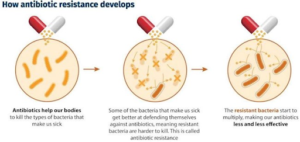In news– A study in 2019 found more than 1 million people a year died from infections linked to microbes that are resistant to antibiotics — more than those who died due to malaria or with HIV/AIDS.
About Antibiotic resistance-
- Antibiotic resistance occurs when bacteria evolve to evade antibiotics. Overuse and misuse of antibiotics are the biggest drivers of resistance. That means that the more we use antibiotics, the worse the problem of antibiotic resistance becomes.
- Antibiotics work by binding to a specific target protein on a bacteria, then entering to kill it from the inside.
- Penicillin, for example, weakens the bacterial cell wall, causing the cell to disintegrate.
- The most common ways bacteria evade antibiotics come from mutations that allow them to stop drugs from binding to bacteria.
- It’s like the bacteria changed the locks so the antibiotic key no longer opens the cell door.
- Bacteria can also achieve resistance by producing proteins that inactivate or modify the antibiotic, so it no longer binds to the bacteria. Or the target protein is mutated so the antibiotic can no longer bind to it.
- But worst of all is when bacteria evolve many of these mechanisms in backup, so even if you overcome one, other resistances might fill the gap.
- Experts describe antibiotic resistance as one of the greatest challenges facing humanity. They predict that if the problem remains unsolved, 10 million people could die as a result by 2050.

How to Solve the problem of antibiotic resistance?
- Antibiotic resistance will always be with us. It’s the nature of evolution by natural selection that means bacteria will always find ways to evade antibiotics.
- But experts are optimistic we can find ways to limit antibiotic resistance in the next decades, at least enough to stop the issue from spiraling into a bigger crisis.
- Unfortunately, it isn’t as simple as developing a drug that will permanently overcome antibiotic resistance.
- It’s incredibly complex science, even more so than finding a vaccine for a virus such as COVID-19.
- For one, there’s huge diversity among bacteria — not all drugs work on a given organism, and not all organisms are killed by a given drug.
- Scientists have been working on the issue from many different angles. One approach is to modify old antibiotics so they overcome resistance.
- Another strategy is to make brand-new drugs, but this approach hasn’t been very successful in recent decades.
















